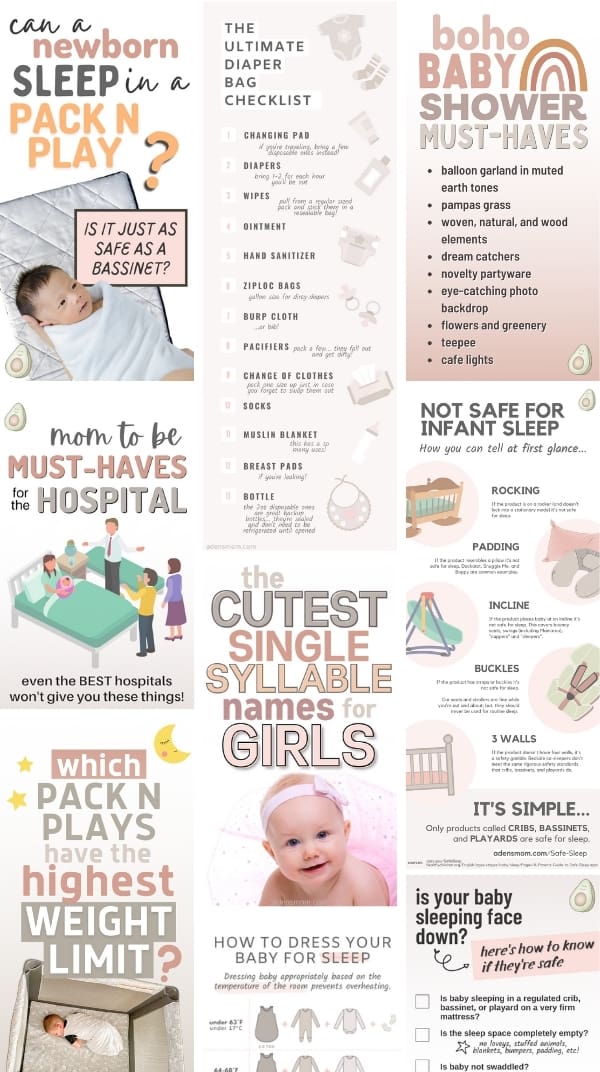Wondering if weighted sleep garments are a SIDS risk? Here’s what we know and what we don’t…
In May of 2020, a mom appeared on Shark Tank with a product she believed was the solution to helping babies sleep through the night.
Lori Grenier invested $100,000 in her company, Dreamland Baby.
In the months since, the brand has been aggressively marketing, reaching out to online influencers, bloggers (myself included), and sleep consultants to advertise on their behalf.
Sites such as The Bump, Motherly, and even First Candle have engaged in profit-sharing relationships with Dreamland Baby.
With all of this notoriety, it’s time we discuss the $100,000 question:
Is this product actually safe?
Update: After publication, First Candle has made it clear that despite their profit sharing relationship, they do NOT endorse this product. They also say that their “Safe Sleep Guardian” seal exclusively addresses whether a company displays safe sleep on their social media—and NOT whether the product being sold is safe.
Table of Contents
- What are “Dream Weighted Sleep Swaddles” and “Dream Weighted Sleep Sacks”?
- How much do the Dreamland sleep products weigh?
- Can using a Dreamland weighted sack increase the risk of SIDS?
- Are there reasons to believe that weighted sacks may be safe for infant sleep?
- What does Dreamland Baby say?
- Additional questions
What are Dream Weighted Sleep Swaddles and Sleep Sacks?
The company Dreamland Baby makes two weighted products for infants.
The products contain poly pellet beads, similar to those found in Beanie Babies.
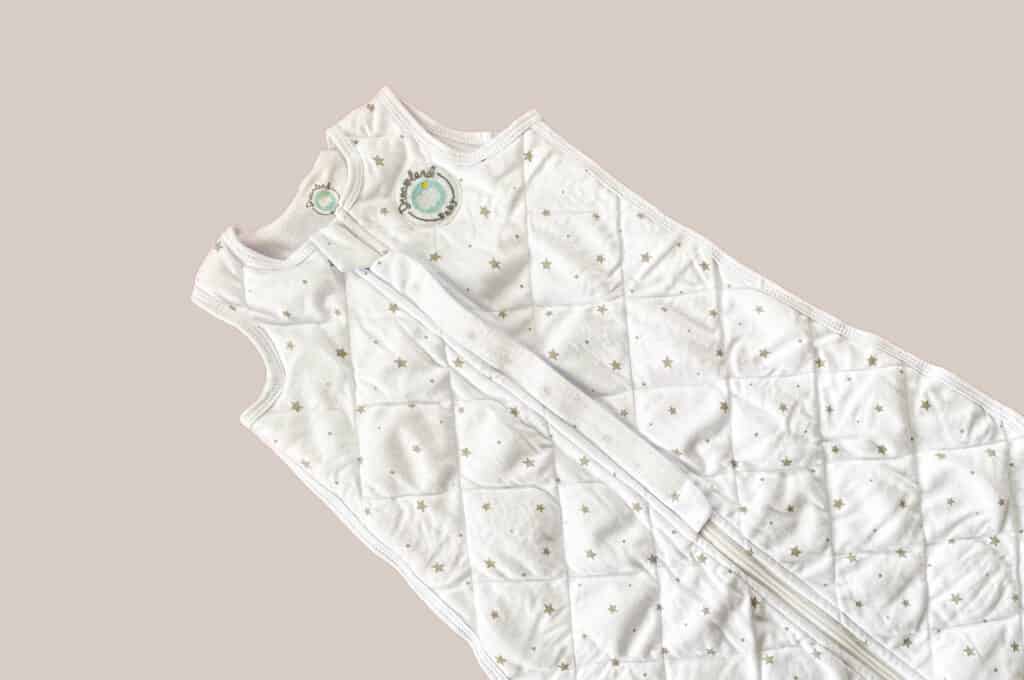
The first product is the Dream Weighted Swaddle Sack which has a band that compresses a baby’s arms. Dreamland recommends this product for infants 0 to 6 months old and 8+ pounds.
The second product is the Dream Weighted Sleep Sack which is for infants between 6 and 12 months old and 15+ pounds. Unlike the swaddle, the sleep sack does not contain the baby’s arms.
According to Dreamland Baby, these weighted sacks “help baby feel calm, fall asleep faster, & stay asleep longer.”
How much do the Dreamland sleep products weigh?
Size Small
The Weighted Swaddle weighs 1lb 7oz.
Dreamland Baby says this is for a baby that weighs 8 pounds.
This amounts to 18% of bodyweight.
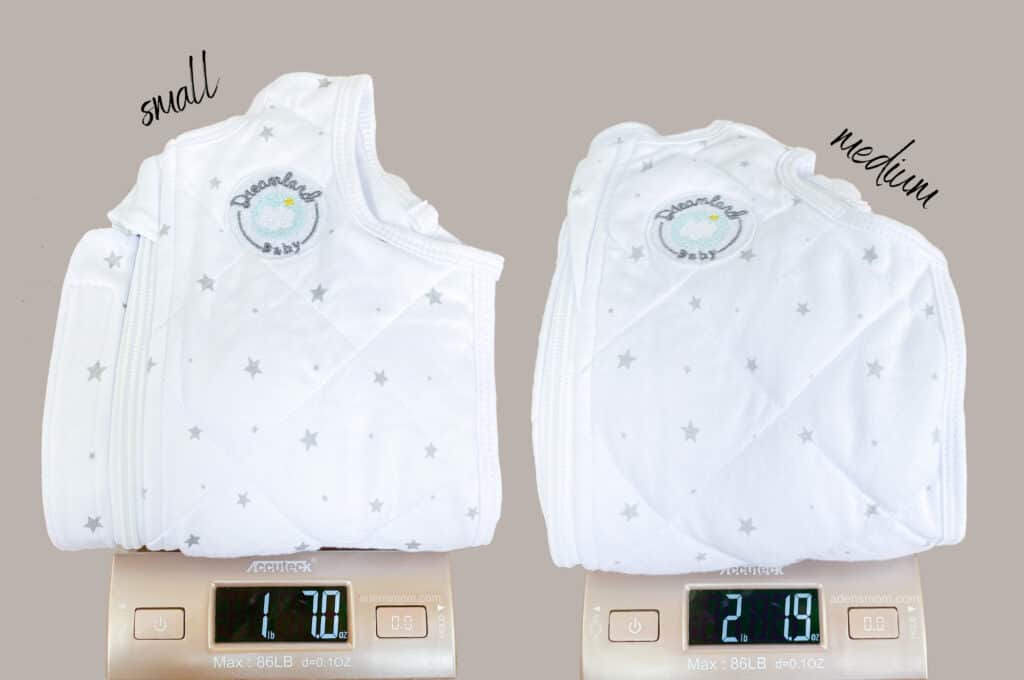
Size Medium
The Weighted Sleep Sack weighs 2lbs 2oz.
Dreamland Baby says this is for a baby that weighs 15 pounds.
This amounts to 14% of bodyweight.
In a moment, we’ll discuss the significance of these numbers and whether weighted sleep sacks are actually “backed by science” as Dreamland Baby advertises.
First, let’s talk about the principle safety concerns of weighted garments for infants.
Can using a Dreamland weighted sack increase the risk of SIDS?
There is insufficient evidence to answer this question with a definitive “yes” or “no.”
But, let’s consider 3 potential areas for concern:
 Added weight may make it more difficult for a baby to reposition themselves.
Added weight may make it more difficult for a baby to reposition themselves.
SIDS researcher and pulmonologist Dr. James Kemp calls weighted blankets for infants “a dreadful idea.”
He explains,
“In prone babies I am concerned about anything that keeps them from lifting and turning their head. A weighted blanket that reaches up to the shoulders or back of the head would keep a baby from lifting and turning to get access to fresh air.”
Dr. Sarah Rahal, a pediatric neurologist, agrees:
“My main concern with these weighted sleep sacks being recommended in infancy is that a child who manages to roll themselves over in one of these sacks may not be able to unroll themselves because of the additional weight, increasing the risk for suffocation.”
“A product that is 18% of an infant’s weight is particularly worrisome for this reason,” Rahal adds.
 Weighted products may relax the autonomic nervous system.
Weighted products may relax the autonomic nervous system.
Wearing a weighted garment stimulates the release of serotonin and dopamine, which causes the autonomic nervous system to relax.
This is the system that controls things like breathing, heart regulation, body temperature, coughing, and swallowing.
These are some of the functions that are theorized to go wrong when a baby dies of SIDS.
 Compression may make it harder for a baby to wake up.
Compression may make it harder for a baby to wake up.
Weighted garments simulate being hugged or swaddled, which causes infants to sleep more deeply.
This sounds like a good thing, but actually, the ability to wake easily is an important protective response to stressors during sleep.
The chairperson of the AAP’s SIDS Task Force, Dr. Rachel Moon, explains this very important connection:
“That is why parents like swaddling – the baby sleeps longer and doesn’t wake up as easily… But we know that decreased arousal can be a problem and may be one of the main reasons that babies die of SIDS.”
Are there reasons to believe that weighted sleep sacks may be safe for infant sleep?
Before we examine the safety claims made directly by Dreamland Baby, let’s consider whether there is evidence that weighted sleep sacks and swaddles may be safe.
A recent study
There is very little research that specifically examines the relationship between weighted garments and SIDS.
There is one recent study on the safety and effectiveness of weighted blankets for infants being treated for Neonatal Abstinence Syndrome (NAS) in the NICU.
The study, which had 16 participants, found “no adverse events” during any of the 30-minute sessions during which the infants were covered with weighted blankets.
The authors recommended continuing to use weighted blankets to treat NAS in infants monitored in a NICU setting.
Notably, this study and its conclusions were limited to infants who wore weighted garments for very short periods of time—and while under constant medical supervision. The authors could not make any conclusions about associations with SIDS in general.
As such, researchers proposed further studies to evaluate the safety of weighted blanket use in non-NICU settings where infants aren’t continuously monitored.
No reported deaths
As of Summer 2021, no deaths linked to Dreamland Baby products have been reported to the CPSC.
While this sounds promising, we can’t be certain that it tells the full story.
Here are 4 things to keep in mind:
1) This is a relatively new product.
Dreamland weighted sleep sacks first became available in 2019. The Shark Tank episode aired in mid-2020.
SIDS is a rare event, so detecting a relationship between any risk factor and an increased probability of death would require observing a large number of events (i.e. uses of the product).
Biostatistician Jonathon O’Brien, Ph.D. explains, “Since the product has not been widely distributed for a long period of time, it is very possible that even if the product greatly increases the risk of SIDS, we would not be able to detect that risk given the currently available data.”
2) Infant deaths are often inadequately investigated.
The CDC warns that many accidental deaths have been “missed” due to retrospective scene investigations, the subtlety of findings, and other factors that you can read about here.
3) Reporting to the CPSC is inconsistent, at best.
Medical examiners are not required to notify the CPSC of the product(s) involved in SIDS investigations.
It’s also rare for individuals who’ve lost babies to report specific products to the CPSC.
4) Data on accidental deaths from US Vital Statistics are not coded by product.
National health statistics use the immediate cause of death (i.e. asphyxia) in their calculations, not the underlying cause of death (i.e. the baby was sleeping under a weighted garment). This may mean we aren’t seeing the full picture.
What does Dreamland Baby say?
Dreamland Baby makes a number of claims defending the safety of their products.
Here are two screenshots of the many mentions of safety on their website.
(Don’t worry if it’s too small to read. We’re about to break it all down.)
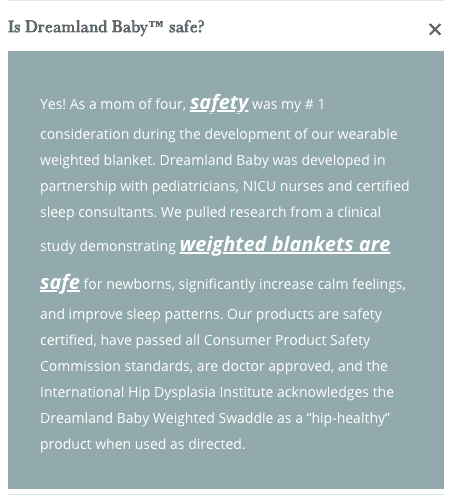
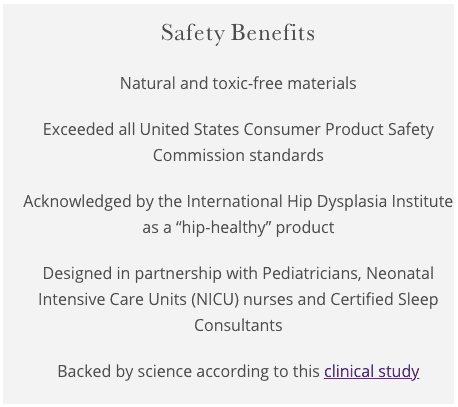
CLAIM #1: "We pulled research from a clinical study demonstrating weighted blankets are safe for newborns..."
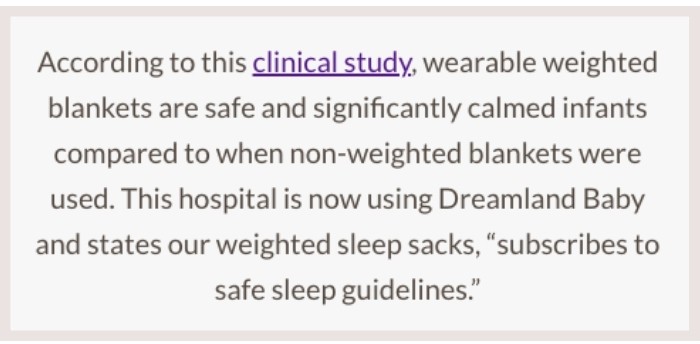
Screenshot from here.
This is highly misleading.
The study they are referring to is the one we just discussed above.
The conclusion of the study was not that weighted blankets are safe for newborns in general.
As stated earlier, this study did not assess risk in the general population at all.
Accordingly, the authors of this paper explicitly state that further studies are needed to “evaluate the feasibility and safety of weighted blanket use in non-NICU settings where infants are not continuously monitored.”
As previously mentioned, studying SIDS risk factors requires large numbers of observations.
The design of this study, with its 16 participants, is completely inadequate for the purpose of assessing risk in the general population.
Dreamland Baby is using this research to claim that their product is “backed by science according to this clinical study”. But, again, the authors of the study never made any claims regarding the safety of weighted blankets outside of the NICU.
As noted earlier, there is some research suggesting that weighted garments are safe over short time periods during continuous professional monitoring.
However, the people interested in this product are not purchasing sleep sacks for the NICU.
As such, they should be aware that the study mentioned by Dreamland Baby has no bearing whatsoever on the potential risks of having their baby sleep in a weighted sleep sack every night.
Simply put, Dreamland Baby is using this study to mislead their customers.
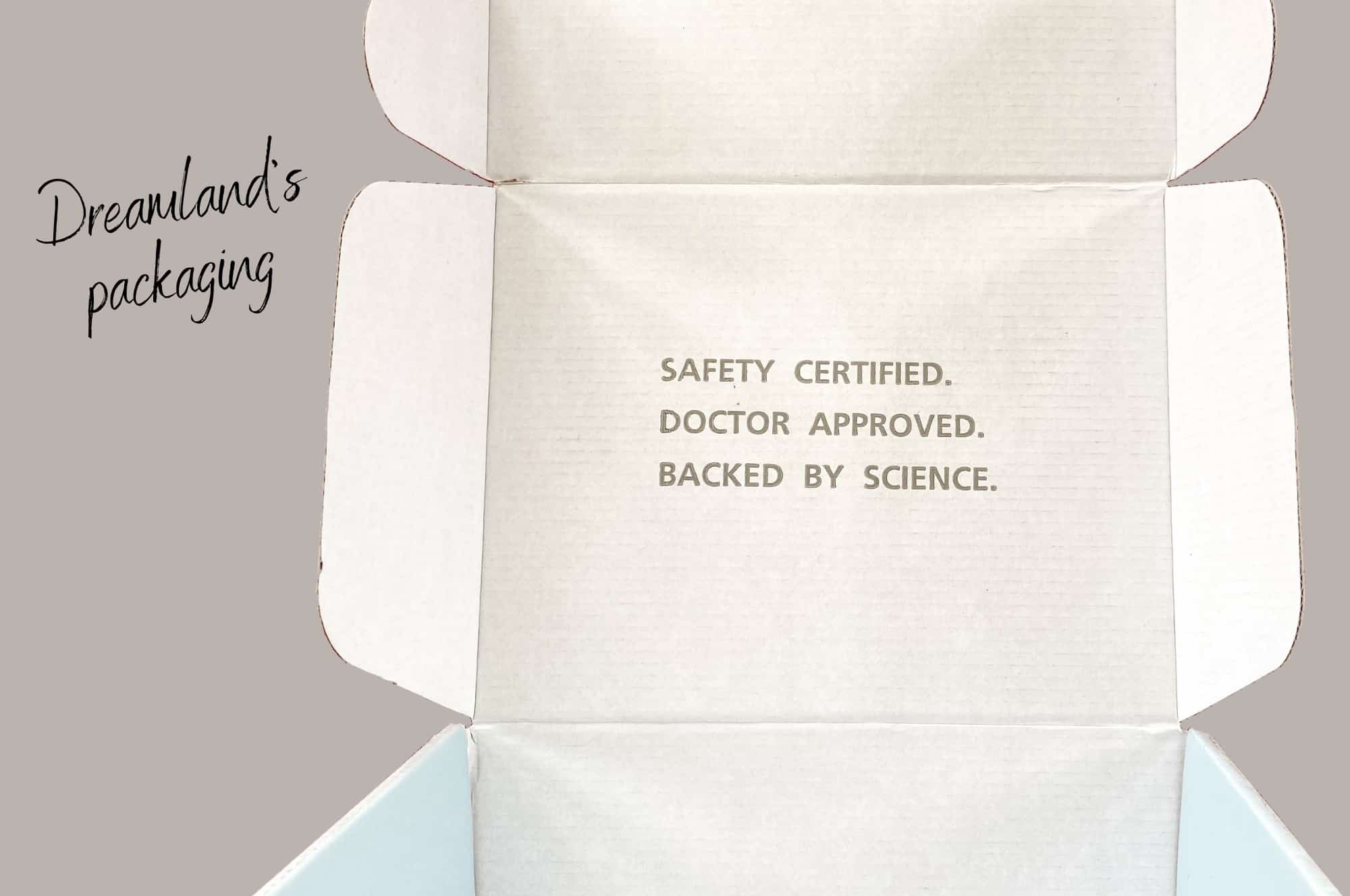
CLAIM #2: "Weight is 10% or less body weight."
As you saw above, we put the products on a scale. The small sack weighs 1lb 7oz. Dreamland says this is for a baby that weighs 8 pounds.
This amounts to 18% of bodyweight, not 10%.
At first glance, it appears that Dreamland Baby did their math wrong.
But when you look closer at the statement quoted above, you’ll notice that they’re referring to the weight of the filling inside the product.
According to Dreamland Baby, the small “contains 0.8 lbs of beads” and the medium “contains 1.5 lbs of beads”. This is how they get to 10%.
This raises the question, is it the beads inside the sleep sack or the total weight of the sleep sack that determines its safety?
As it turns out, there are no standards and no evidence regarding either.
Though, you might not have that impression after reading their marketing:
“The product follows the recommended weighted blanket safety guidelines of never having a weight more than 10% of your baby’s body weight.”
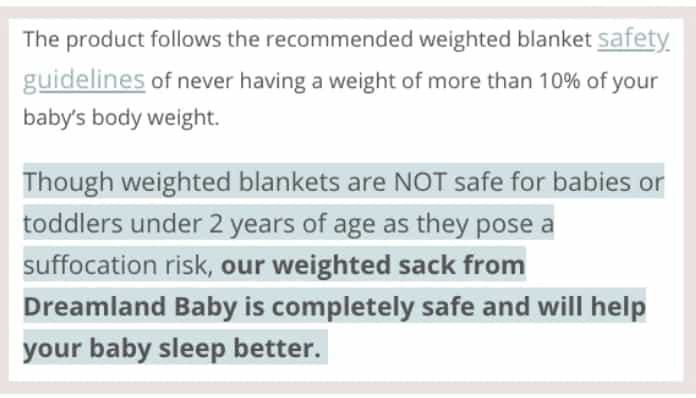
Screenshot from here.
The link to their “safety guidelines” takes you to a blog post recommending weighted blankets to purchase.
The blog post claims that 10% is a reasonable safety threshold for adults and adolescents, but says nothing about infants.
In fact, their chart containing safe weight recommendations starts at a bodyweight of 100 lbs.
Is this age distinction simply a matter of semantics?
No.
Adults and adolescents are not at risk of SIDS. What’s safe for an adult or adolescent is not necessarily safe for an infant.
In summary, Dreamland Baby sleep sacks are not “10% or less body weight”—and there is no reason to believe that a 10% threshold is actually relevant to SIDS risk.
Onto the next claim…
CLAIM #3: "Weighted sleep sacks... are considered safe in general for babies who can roll over."
If you’ve heard of the “Back to Sleep” campaign, you probably know that babies should sleep on their backs to markedly reduce the risk of SIDS.
There is one notable caveat, though.
When babies roll over in the crib after being put down on their backs, parents can leave them to sleep on their bellies.
The presumption is that once babies are developmentally capable of rolling, they are able to reposition themselves if they’re having trouble breathing.
But what happens when a baby is wearing a weighted sleep sack?
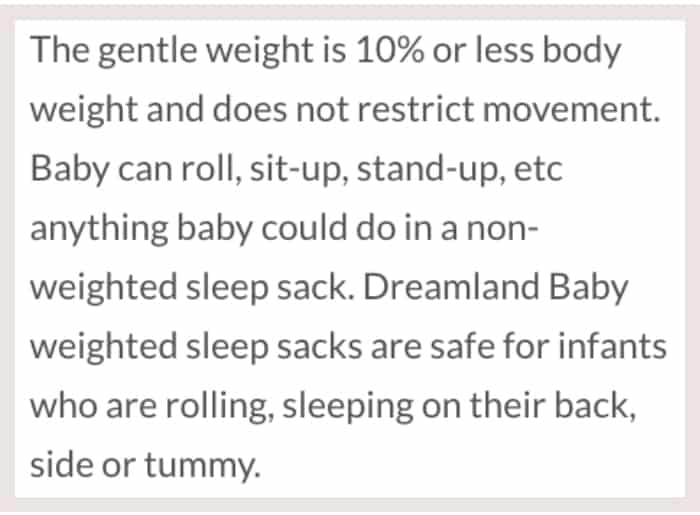
Screenshot from here.
Dreamland’s position is that their product does not inhibit movement.
They offer this claim without evidence—and it’s kind of hard to believe.
Pediatrician Dr. Gina Posner is skeptical:
“If a baby manages to flip over and then, because of the weight, they are unable to flip back, I worry about them suffocating,” she says.
You’ll also recall that stomach sleeping in a weighted garment was the primary concern of SIDS researcher Dr. Kemp.
It’s worth repeating his explanation shared earlier:
“A weighted blanket that reaches up to the shoulders or back of the head would keep a baby from lifting and turning to get access to fresh air.”
In summary, while we don’t have definitive studies regarding weighted sleep sacks, medical professionals have serious concerns about what we might find once those studies emerge.
CLAIM #4: "Dreamland Baby was developed in partnership with pediatricians, NICU nurses and certified sleep consultants."
It’s unclear who exactly they are referring to. But even if we had specific quotes from medical professionals, it would not change the current state of the research on weighted garments for infants.
There simply have been no high-quality studies that would allow us to draw any conclusions regarding the link between SIDS risks and any weighted sleep garments.
There is, however, an ever-improving understanding of the physical mechanisms that result in SIDS; and as explained earlier, there are multiple connections between the potential causal mechanisms of SIDS and weighted sleep garments.
Given these possible connections, the principled concerns of researchers and medical professionals should not be disregarded without substantially more evidence than we have available today.
CLAIM #5: "Prior to its release, safety testing and a clinical trial demonstrating safety were completed by Dreamland Baby."
At first glance, this looks like they’ve gone above and beyond to make sure that their product is safe.
Unfortunately, none of the 3 studies they linked to were designed or intended to assess whether or not weighted sleep garments have any impact on SIDS risk.
In addition to the 3 published studies, other safety features such as organic threads are hyped up.
If you thought the sack was made out of garbage and were worried about your baby getting a rash, this may put your mind at ease.
But if you’re worried about SIDS, none of this matters.
CLAIM #6: "Approved by Pediatric Pulmonologist for breathing safety."
Note the recurring theme where Dreamland Baby claims to have evidence or expert testimony supporting the safety of their products, but this evidence falls apart upon closer inspection.
Considering this pattern, we ask again: who is this pediatric pulmonologist and what exactly did they say?
To the best of my ability, I cannot find any information on their website substantiating this claim.
CLAIM #7: "Dreamland Baby has exceeded all United States Consumer Product Safety Commission standards."
Currently, there are no CPSC guidelines that directly discuss sleep sacks and swaddles.
The CPSC standards they’re referring to are for flammability, lead content, colorfastness, sharp edges, and other textile-related matters.
(None of this has anything to do with SIDS risk.)
CLAIM #8: "...a product that [adheres] to the American Academy of Pediatrics safe sleep guidelines."
The guideline they’re referring to is the recommendation to use a sleep sack instead of a loose blanket.
At no point in the guidelines does the AAP directly discuss weighted sleep sacks.
CLAIM #9: "Neither the AAP nor the CDC has ever told consumers not to buy Dreamland Baby’s weighted sleep sack. "
This is true.
But it is also true that neither the AAP nor the CDC has ever told consumers not to let babies sleep with chainsaws in their cribs.
The list of things that the AAP and CDC have not said is very long.
The AAP and CDC are unlikely to call out any product by name.
Further, the AAP has not yet released a statement on weighted sleep sacks. It’s coming this winter.
Now let’s examine one final claim…
CLAIM #10: "Dreamland Baby [helps] to create a new norm for content on social media, only showing babies in a safe sleep environments."
This couldn’t be further from the truth.
Their social media and reviews page show many dozens of images, one after another, of infants sleeping in dangerous conditions, many of which are known to be highly correlated with SIDS.
Here are a few examples of unsafe sleep pictured on Dreamland Baby’s website and instagram:
- Babies sleeping with bumpers in the crib (these are not only unnecessary but dangerous)
- Babies sleeping in padded loungers (Dockatot, Boppy, and Snuggle Me are NOT safe sleep spaces)
- Babies sleeping in swings and Mamaroos (these are NOT safe sleep spaces either)
- Babies sleeping on anti-flat head pillows (these are unnecessary and are suffocation hazards)
- Babies sleeping with loveys in the crib (these are suffocation hazards)
- Babies sleeping with loose blankets and loose waterproof pads (this is a well-studied suffocation risk)
- Babies sleeping with pacifier clips (only pacifiers are safe in the sleep space)
- Babies sleeping in an adult bed (even “firm” adult mattresses are not as firm as safe infant mattresses)
Does Dreamland Baby know these things are unsafe?
You’d think all the pediatricians, NICU nurses, and certified sleep consultants they partnered with might have pointed it out.
Oh wait. Maybe they did.
Here’s a blog post on Dreamland Baby’s website. It says, in part,
“…many moms think it is perfectly safe to have their baby sleep in a large cushion, pillow, co-sleeper, or positioner. Unfortunately, all of these break two of the most important safe-sleep rules: 1) place baby to sleep on a firm surface 2) put nothing in baby’s sleep space.”
It bears stating the obvious:
Dreamland Baby is a company that makes money selling a product.
VI. Additional questions related to Dreamland weighted sack safety
Is Dreamland Baby being honest about their sleep sacks being 10% of body weight?
Not always.
Take a look for yourself…
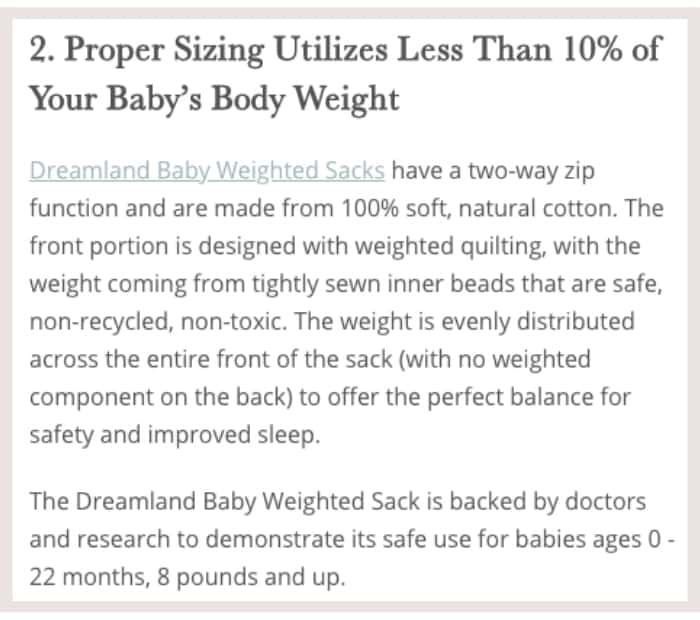 Screenshot from here.
Screenshot from here.

Screenshot from here.
Side note: In the screen shot above, we have no idea which pilot study they are referring to that “showed that these were safe at 20%”.
Dreamland Baby’s dishonesty aside, it’s worth reiterating that there is no such thing as a ‘10% of bodyweight’ safety standard for infants.
Why haven't weighted garments for infants been studied more?
In regard to the difficulty of safely studying upper weight limits, Michelle Barry of Safe Infant Sleep notes,
“This is one of those things that everyone wants specifics about, but there are no studies. It would be unsafe to do such testing. Adding weight to the chest of an infant to find out how much it would take to create distress is against what medical professionals want to do. It’s similar to the fact that we would never tell a pregnant individual to consume something dangerous to see what the effects would be.”
According to Pediatrician Dr. Gina Posner,
“Honestly, I am not sure why they aren’t doing more research. I think it wasn’t really a big deal until recently because [companies] weren’t making weighted garments for infants, only for kids and adults. They should do more research, but anything that traps a kid from rolling and can lead to suffocation is just not safe.”
Dreamland sleep sack vs Nested Bean: How do they compare?
If you’re interested in weighted sleep sacks, you’re probably familiar with Dreamland’s primary competitor, Nested Bean.
Here’s how they compare:
- The size small Nested Bean sack weighs just over 7 ounces. It’s intended for a 7-pound infant. This amounts to 6.4% of body weight.
- The size small Dreamland Baby sack is one pound heavier than this, weighing 1 pound 7 ounces. It’s intended for an 8-pound infant. This amounts to 18% of bodyweight.
Both claim to meet the same safety guidelines.
Read more: Are Nested Bean Sleep Sacks Safe?
Are weighted sleep garments safe for children?
The AAP has not taken a stance on this yet.
According to the NHS (the UK’s healthcare system), there isn’t enough data to guide the safe use of weighted garments for children, even in a therapeutic setting.
As such, the NHS discourages the use of weighted garments for children.
If parents and caretakers choose to use these products despite their warnings, the NHS has provided a list of precautions to minimize the risk.
As you’ll see, all of these precautions preclude the use of weighted garments for infants:
- The child must be able to remove the blanket or get free of the blanket by themselves.
- The child must be supervised at all times when under the blanket.
- The blanket/other weighted products are not to be used for longer than 20 minutes which would prohibit lengthy nighttime use.
Articles related to Dreamland Baby sleep sacks and swaddles:
- Are Nested Bean Sleep Sacks Safe?
- Baby Merlin’s Magic Sleepsuit: Is it Safe?
- Baby vs Crib: Common Issues and How to Fix Them (Limbs getting stuck, hitting head on the crib, chewing the crib rails)
- How to Keep a Baby Warm at Night (Evidence-Based Guide)
- When and How to Stop Swaddling: The Ultimate Guide
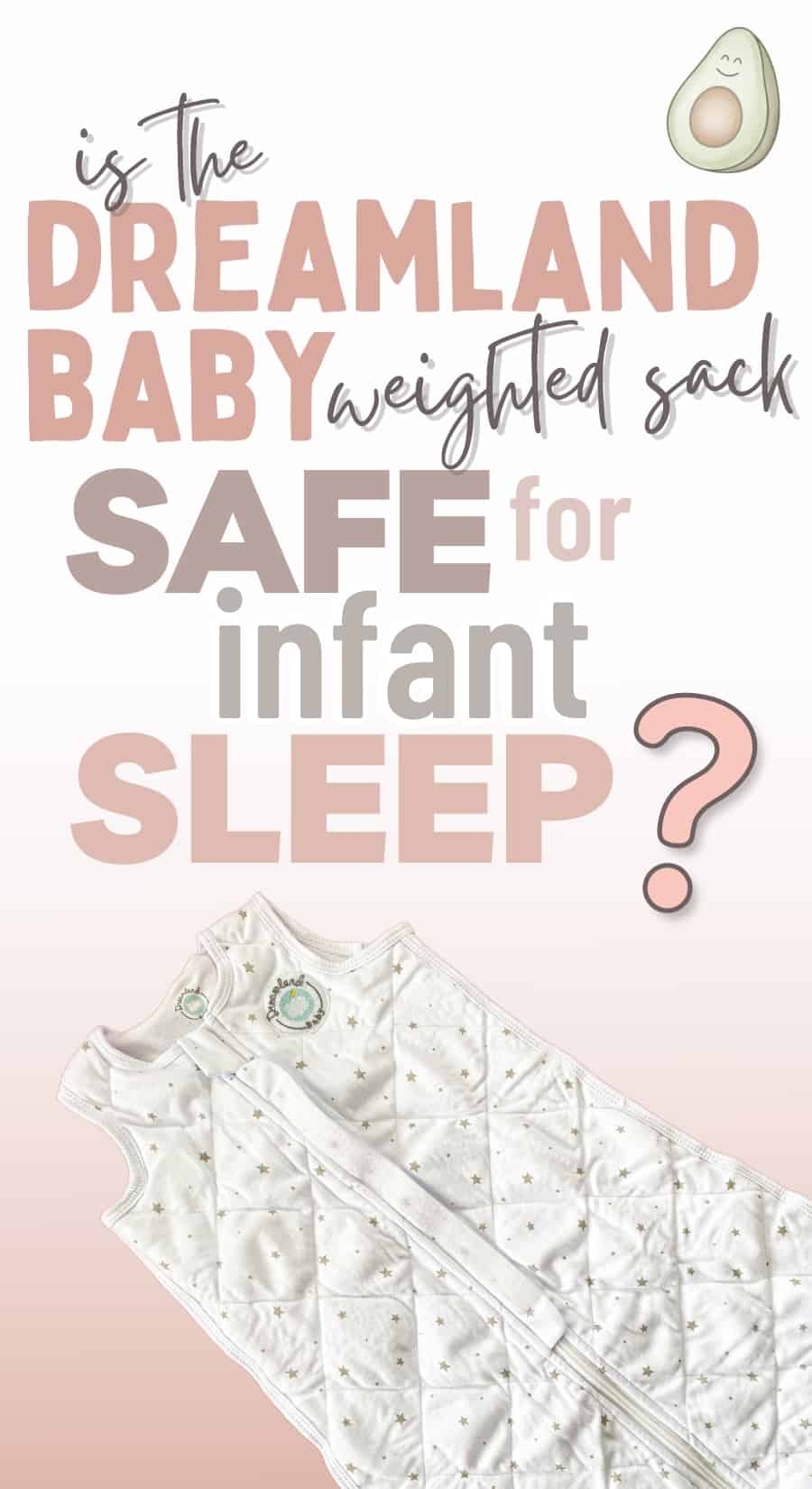
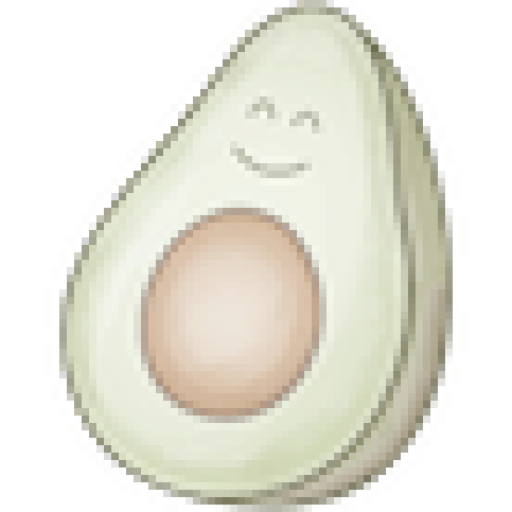
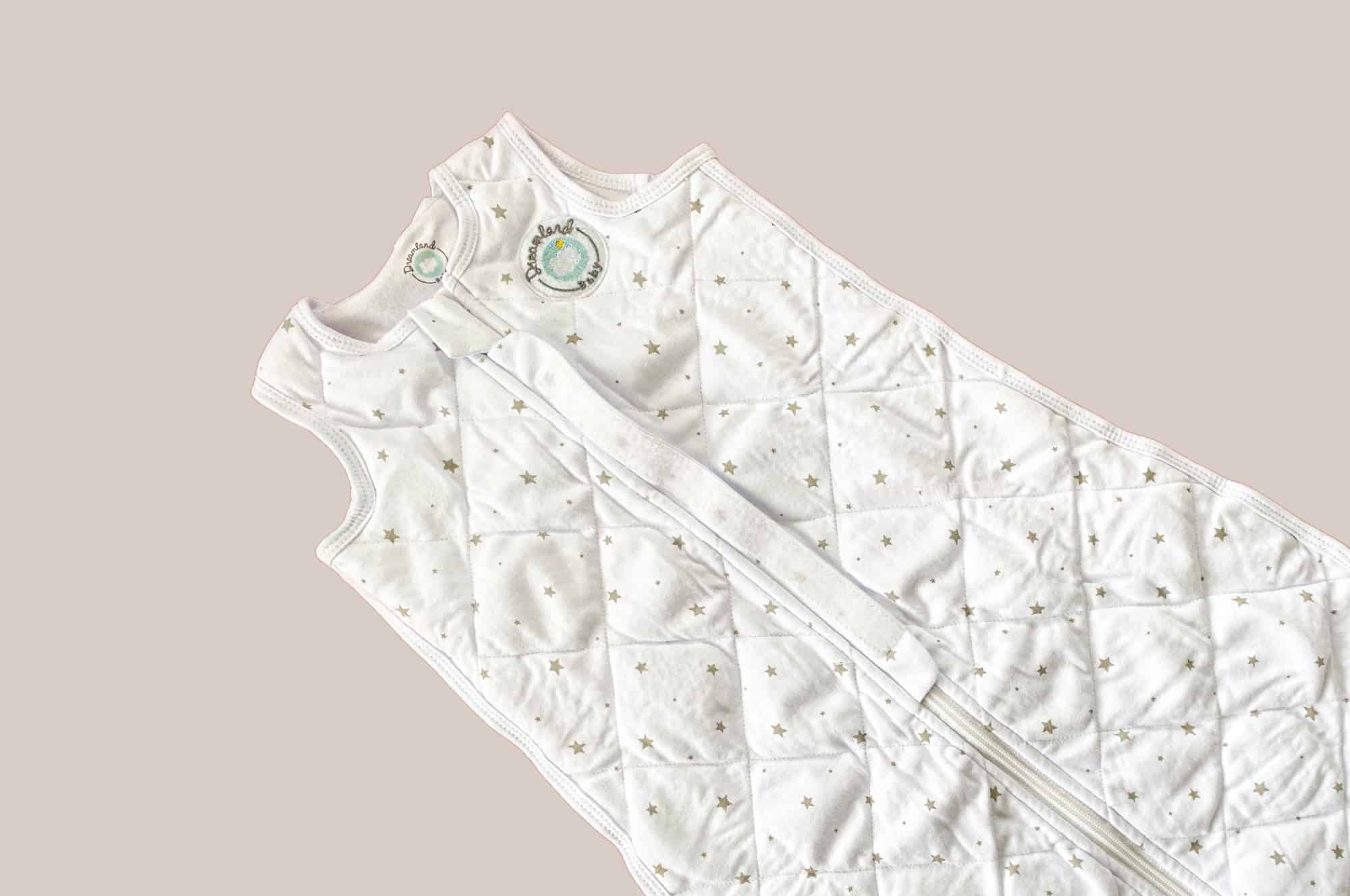
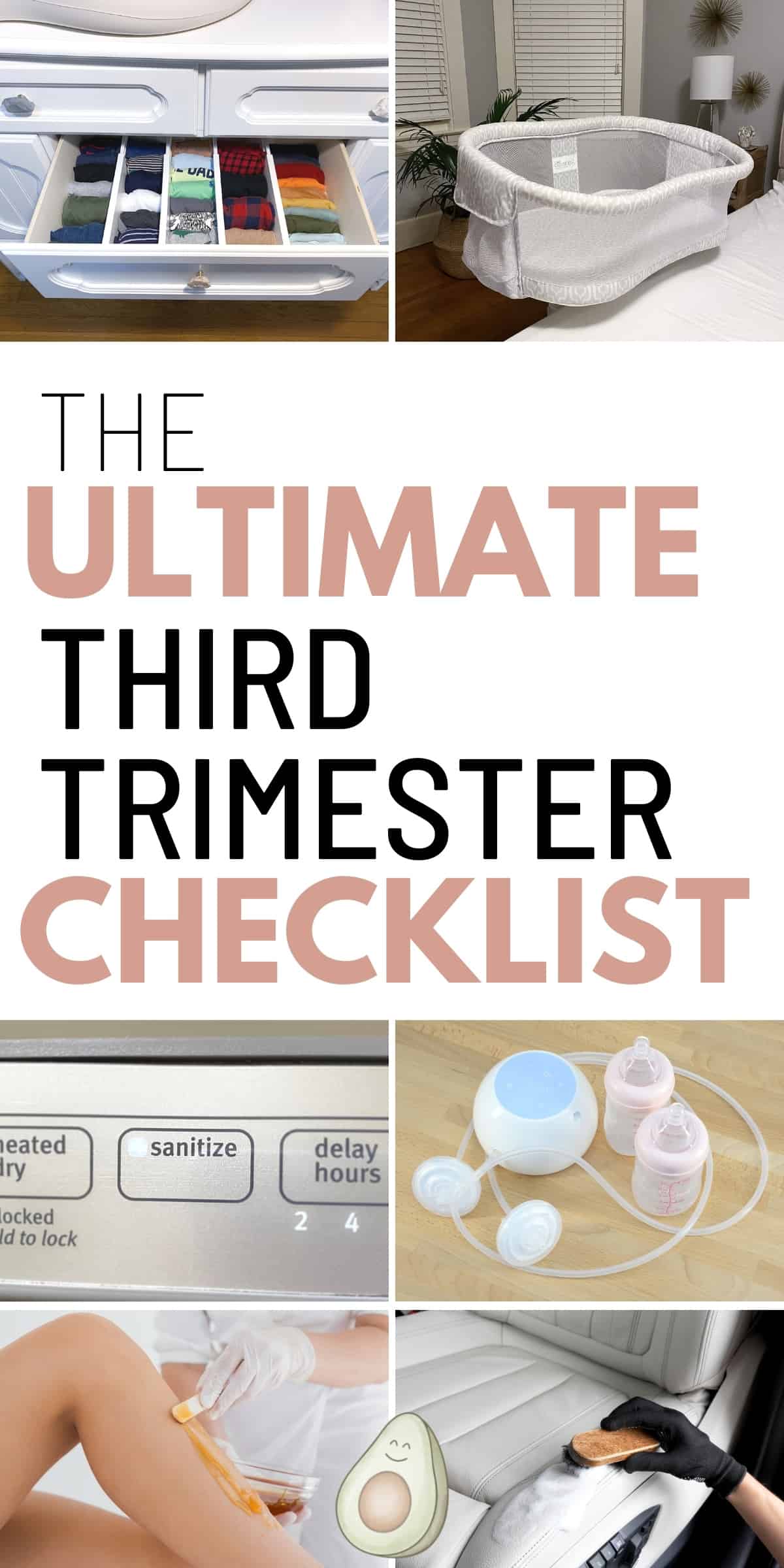
 Follow on Pinterest
Follow on Pinterest